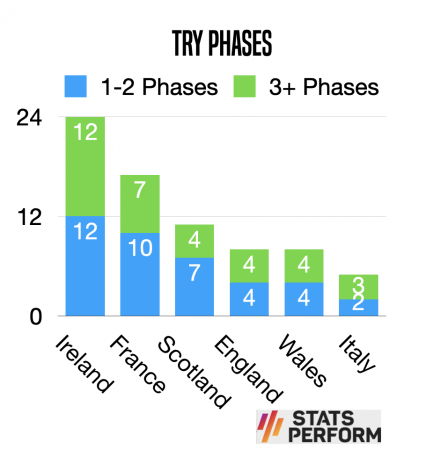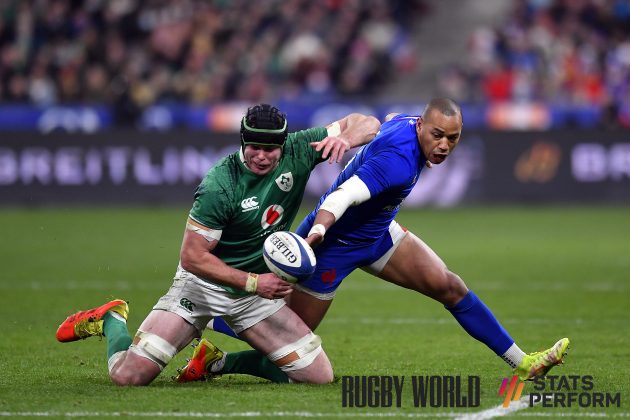France and Ireland play very different styles of rugby. Here’s how, according to numbers from Opta by Stats Perform...
Six Nations analysis: A tale of two playing styles
France are Grand Slam winners and supreme Six Nations champions. A side that have had an answer for everyone they came up against.
Ireland finished second after a campaign that – were it not for one bum note in Paris – could have been one for the ages.
And yet, while both France and Ireland were head and shoulders above their competitors in the championship and occupy a tier of their own right now, the two sides could not be more different. They have distinct styles, yes, but those styles are unalike, as these stats from Opta by Stats Perform make clear…

Averages across the whole tournament
As you can see from France’s average numbers all tournament, they are very happy to play without the ball. Last in the whole tournament for (average) time spent in possession, and fifth for average carries and average metres made, this is a team who don’t mind saying to their opponents: “Yours!”
Their kicking figures push this further. Italy are the only side to kick more than France, and even then, Italy only slipped past them in the closing round. France led on kicking numbers for the first four rounds. And while Ireland did better than France for (average) territory number, it is also clear that France were happiest kicking it as far down your throat as possible, going much longer in distance than their rivals.
As analyst Ross Hamilton tells us from looking at these stats: “France backed their defence to stop their opposition and turn the ball over in playable positions. They didn’t let their opposition out easily either, with just 2.3 line breaks conceded per game. They also allowed the fewest offloads and their discipline was very good across the board.”

Gregory Alldritt offloads to Antoine Dupont (Getty Images)
Of course, when France got into opposition red zones, they would go for the jugular.
Whatever scant possession they had they kept it alive impressively – laying on the most offloads from the least possession. And when they fancied it they got into the right areas frighteningly often.
They may have had the second best points per entry, behind Ireland, but when it came to claiming points of any kind when they got into the opposition 22, no one scored with the frequency France did.

Ireland’s averages
Now look at Ireland. What you see is a game all about volume and pressure. They are happy to make mistakes because they will get you again.
At this stage, you have to credit the fine conditioning work of the provinces and the relationship fostered between them and Ireland, via Jason Cowman. To play Ireland’s way takes outrageous physical output.
To hit the most rucks with an average of more than 100 per game, and with 71% of all rucks under three seconds and superbly accurate, puts unbelievable stress on opposition. Add in the fewest turnovers conceded and the most breaks and it feels like a sick joke.
And it’s output on the other side of the ball too. What they gain in attack, they limit in defence. Ireland allowed the fewest number of opposition rucks and made those rucks the slowest of any team, so in turn they are rarely under pressure. Along with their other defensive averages, it underlines the sheer effort this Ireland side put in.
As Hamilton concludes of Ireland’s scoring approach: “They get to the red zone the most and then stay there, playing the most, having the most phases within it and ultimately coming away with the most points per entry. It takes more time than France but they are still very efficient with all that pressure.”

Line break heatmap
The difference between the two sides in attack is also emphasised by where the two sides make their line breaks.
As you can see from the heatmaps showing where breaks were made, Ireland clearly have an all-pitch approach to contrast’s France’s work to create space on the edge. France only had two line breaks that were down the middle all tournament.
Damian Penaud and Gabin Villiere made six line breaks each – that’s 35% of France’s total. And Yoram Moefana (while he was on the wing) and Melvyn Jaminet also made three each, meaning that 53% of France’s total line breaks were made by back-three players.
Just to show the difference from a third team, we have included a view of England, who appear more like Ireland-lite in their pattern (and lite is fair – as they made the fourth most line breaks all tournament, averaging 4.0 per game, compared to Ireland’s table-topping average of 7.5). In fact, all the other teams had break maps similar to this, making France’s look so distinctive and unique.
It is also worth noting the ten players who, on three occasions in this Six Nations, made passes to unleash line breaks. One from England (Marcus Smith), two French (Antoine Dupont and Gael Fickou), two Irish (Tadhg Beirne and Jamison Gibson Park), two Italian (Callum Braley and Edoardo Padovani) and three from Scotland (Chris Harris, Finn Russell and Stuart Hogg). There were none from Wales.
Yes, one forward is up there on the list. Ireland’s Beirne. In fact, while we’re on tournament-wide trends, there were 22 ‘line break passes’ from forwards in this Six Nations, meaning that 26.2% of the 84 total passes to create a break came from the bigger blokes. Remember that next time someone says there’s no skill in rugby anymore…

And just to add another layer to this, look at the breakdown of how many tries teams scored from two phases or fewer, or from three-plus phases.
As you can see, Ireland and France are out ahead of the rest, and while Scotland were much better than the other three in terms of tries from one or two phases, the top tier of France and Ireland are untouchable for multi-phase scores.
Download the digital edition of Rugby World straight to your tablet or subscribe to the print edition to get the magazine delivered to your door.
Follow Rugby World on Facebook, Instagram and Twitter.





